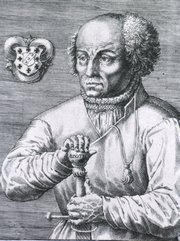Paracelsus (1493 – 1541). Swiss physician and alchemist , Phillipus Aureolus Theophrastus Bombast Von Hohenheim was born in Einsiedeln in 1493 (one year after Columbus discovered America) in what is today is Switzerland. At an early age he became a migrant student, visiting several universities including T?bingen, Vienna, W?rttemberg, Heidelberg, and Cologne. There is discussion as to whether he received or not a medical degree, although most authors today agree he might had. In 1510 he moved to Ferrara where he attained (apparently) his medical degree in 1516. During his constant travels he started to understand that folk medical treatment based on actual observation was better than what was published and followed blindly by the physicians of the time.
He started to call himself “Paracelsus” which means “alongside Celsus”, seen as one of the greatest physicians in history. Paracelsus continued his travels, visiting Egypt and Jerusalem. It is at this time that he started delving into the world of alchemy, returning to his home circa 1524.
Paracelsus was appointed “Town Physician” of the city of Basle but created controversy when he started lecturing in German (not Latin) and invited the general public as well as his students to his lectures. In his presentations he introduced the concepts of direct observation of the patient and empirical treatment, based his statements on experiments and reasoning opposing the “classics” Galen, and Avicenna.
|
Original image courtesy of the National Library of Medicine
|
| In 1527, during a demonstration he publicly burned the works of Avicenna to prove his point. This caused a backlash from the university and town authorities who expelled him in 1528. From this point on, Paracelsus’ life is constant wandering. He settles for a time and then travels again. In spite of his disdain for the works of the “medical greats”, he himself writes a large number of works, including medicine, surgery, theology, astronomy, magic, etc. Many of these works are not published until after his death as he is considered to be contradicting Galen. In 1530 he writes the best description of syphilis and recommended its treatment with mercury.
In 1541 he was appointed to a post on the staff of Duke Ernest of Bavaria, but he died in mysterious circumstances on September 24 of that year at the White Horse Inn in Salzburg.
Paracelsus is a controversial image, bound in legend. For many, Paracelsus was bombastic, quarrelsome, opinionated and a drunkard. For others he is a figure of his time, clashing with the classics and giving us a new way to look at the world and at diseases. He taught that wounds must be allowed to drain and not, as was common, packed with unhealthy materials. According to him, the human body primarily consists of salt, sulphur, and mercury, and it is the separation of these elements that causes illness. He introduced mineral baths and made opium, mercury, lead and other minerals part of his treatment, foreshadowing modern pharmacology with the use of chemical remedies, mercury for syphilis, laudanum and antimony. Paracelsus stated in 1538 that “Everything is a poison, the dose alone which makes a thing not a poison”.
I just discovered an interesting chain of events. For a time Paracelsus had a medical student that later decided not to continue his medical studies and instead dedicated himself to the new art of printing. His name was Johannes Oporinus and he was the printer that Andreas Vesalius selected to print his masterpiece, the "Fabrica".
Sources
1. “Paracelsus” Abbott.A. Nature 366: (1993) 98
2. “Paradigm lost: a celebration of Paracelsus on his quincentenary” Feder. G. Lancet. 341: (1993) 1396-1397
3. “Does Paracelsus deserve a place in the medical pantheon?” Bynum, B. 367: (2006) 29; 1389–1390
4. “Paracelsus: founder of medical chemistry” Endeavour 15:4 (1991) 147
5. “Paracelsus: the medical Luther” Leary B. 73: 3(1984) 131-133
6. “Paracelus and the Philosopher’s Stone” TenHoor, W. Am J Surg (1935) 30:3 563-572
|



